|
For anyone involved in the protest movement, the word 'sabotage' has honourable origins. For those who do not know, it derives from action undertaken by 15th century Dutch workers who, fearing that their jobs would be rendered obsolete by machinery, threw their wooden shoes – known as sabots – into the wooden gears of textile looms with the intention of breaking the cogs. It is a spark from which all subsequent industrial action and active dissent was effectively born, and worth treasuring at a time when the current government is looking to silence the few legal avenues of protest that remain for the working person. It is doubtless that same government's awareness that, in the right hands, the computer has the potential to become the sabot of the 21st century that has prompted the recent revival and expansion of the controversial bill to monitor and record just about everything every one of us does online. If there was ever a time to start looking at how you can encrypt your data and hide your presence on the net from prying eyes, then surely this is it (given the sheer volume of data and identity theft that takes place every day, it's not a bad idea anyway).
But I digress. As an offensive action during wartime, sabotage was (and doubtless still is) valued by governments and resistance forces alike. A skilled saboteur can bring the production of munitions or the transport of essential supplies to a temporary but potentially damaging halt, or demoralise the public by spreading fear and paranoia. There are saboteurs amongst us! Who can we trust? Divide and conquer, that's the ticket. Funny how we keep coming back to government policy...
The great Alfred Hitchcock was clearly interested in sabotage as a thriller concept. In the USA in 1942 he made Saboteur, in which a man wrongly accused of starting an aircraft factory fire goes on the run and eventually unmasks the real culprits. Six years earlier, whilst still based in Britain, he directed Sabotage, a darkly toned thriller that although made three years before the outbreak of World War 2, anticipates the potential threat that would be posed by fifth columnists in the conflict to come.
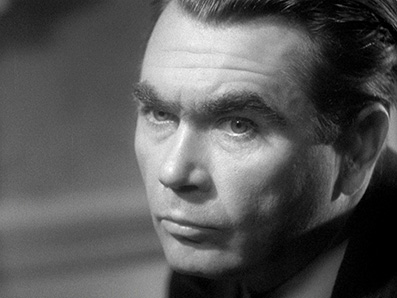
Unlike Saboteur, which employed Hitch's favourite 'wrong man' story structure, Sabotage identifies its bad guy up front and outlines his crime with thrilling economy. A light bulb flickers. The voltage level drops. The streets of London are plunged into darkness. Four officials investigate a power generator and find sand in the works. Who could be responsible? A sinister looking man (played by the splendid Oscar Homolka) walks towards the camera. Total elapsed screen time: 45 seconds. Wow.
There are a number of ways in which the film differs from what became the Hitchcock norm. The first is that there is no traditional leading man. As with Hitch's first sound film, Blackmail, the lead character here is female, signalled at the start by Sylvia Sydney's top-of-the-bill credit. Sydney plays Mrs. Verloc, the wide-eyed co-owner of the aptly named Bijou cinema. Curiously, her first name is never mentioned here, but she's called Winnie in the source novel so I'll go with that. When we first meet her, she is looking for reasons not to pay a refund to customers whose enjoyment of the film show has been disrupted by the power cut. It's not that she's mean-spirited, more that the cinema simply cannot afford the refund. If only her husband were here. A short while later he sneaks into the premises and makes it look like he's been upstairs all along. And we know his face by now, having been introduced to it at the tail end of the above-detailed opening sequence. Is he really the saboteur? When he washes his hands and leaves a deposit of sand in the clean white sink there appears to be no doubt. When his unknowing wife finds him pretending to be asleep, he suggests she give the punters back their money. No point in upsetting the public, he reasons. Don't worry about the finances, he reassures her, he has some money coming in soon.
By the time Winnie returns to the box-office, cocky Ted Spencer from the greengrocer next door has all but convinced the previously intransigent customers to live with the fact that there's going to be no refund. Winnie is annoyed at this interference, but good-looking Ted clearly has an eye for the older Verloc's attractive young wife. Or is it Verloc himself that he is really interested in? All is soon revealed (I'll leave that one for the film), and the next day Verloc trips off to meet a fellow conspirator at the London Zoo aquarium, where he is given instructions for his next job, one that is set to have a far greater impact than the previous night's power cut. Verloc initially refuses to take part in an operation that will cause loss of life, but with his masters unhappy at the impact of the power cut (cheery Londoners just laughed it off), his payment for that job is to be withheld until he has completed this new and more deadly task. In one of the film's most inventive visual touches, a vision of a London street that appears to Verloc in an aquarium tank collapses as if being pulled down into the earth.
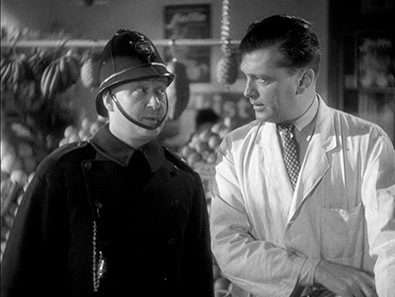
Following its briskly handled opening, Sabotage initially proves a tad slow to engage with (not a problem the second time around, I should point out), a process hampered in part by an absence of the sort of clear narrative drive that distinguishes the best of the director's 'wrong man' films. Verloc is a saboteur, his wife is unaware, and the cops are keeping an eye on his activities. Ted is also not as charismatic as he really needs to be, the result in part of the compromise casting of John Loder when first choice Robert Donat had to drop out due to illness. There's nothing technically wrong with Loder's performance (his look of regret when Winnie talks about her husband's kind and homely nature is nicely pitched), but there's preciously little that's exciting about it either. Which is rather a shame, as his attraction to Winnie is a potentially boundary-testing one for its day, given that she is married and contentedly so, at least for now. There is thus some intrigue, but where is the tension? Oh, just you wait.
This leads me to the most discussed and (in-) famous sequence in the film, one I can't elaborate on without delivering an almighty spoiler on first-timers, something I have no wish to do. But given that a key aspect of this sequence is unique in Hitchcock's filmography, I can't just ignore it, particularly as I'm going to take issue with some of the more negative critical reaction to it. I'm also going to reveal how the film concludes, another sequence that is worthy of attention but that rarely gets discussed. This is thus one of those times when if you are new to the film then I'd stop reading here or simply hop ahead to the final paragraph of this review, which you can do by clicking here.
If you're still reading then I can presume you've seen the film or read about the sequence I'm about to discuss. If not, well don't blame me when the tension it creates for newcomers is completely ruined for you.
As those of you who know the film will recall, Verloc is given a bomb to plant in an underground station cloakroom, one timed to explode at 1.45pm on the Saturday of the Lord Mayor's show. With police stationed outside the cinema and Ted – who by this point we know is working undercover for Scotland Yard – effectively barring his exit, he is unable to transport the device to its intended destination. He thus enlists the help of Winnie's teenage brother Stevie, asking him to deliver two film cans to another cinema and to drop the parcel containing the bomb at the station's left luggage office on the way. What follows is as nail-chewing a sequence as you find anywhere in Hitch's enviable oeuvre, as Stevie encounters all manner of delays en route, completely unaware that the parcel under his arm is timed to explode at a fast-approaching hour. The shooting and particularly the editing of this sequence is genuinely masterful – Hitch was heavily influenced by Russian silent filmmakers' work with and theories on the power of montage – and it builds to an almost unbearable pitch. And then the unthinkable happens – instead of Stevie just getting to his destination in time or a wire coming loose and disabling the device, the bomb explodes, killing everyone on the bus that Stevie has blagged a ride on, the boy included.
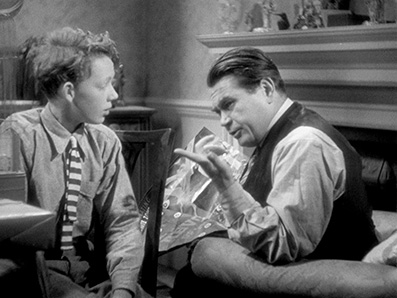
Although true to the source novel (Joseph Conrad's The Secret Agent, which coincidentally was the also title of Hitchcock's previous film), it's a decision that has been repeatedly criticised and that Hitchcock himself later regretted. His reasoning was that if you're going to unexpectedly kill one of the main characters in a film, then you shouldn't spend ten minutes winding the audience up into a frenzy of anticipation about how he will escape with his life.
Hitch himself explained it thus:
"Four people are sitting around a table talking about baseball or whatever you like. Five minutes of it. Very dull. Suddenly, a bomb goes off. Blows the people to smithereens. What does the audience have? Ten seconds of shock. Now take the same scene and tell the audience there is a bomb under that table and will go off in five minutes. The whole emotion of the audience is totally different because you've given them that information. In five minutes time that bomb will go off. Now the conversation about baseball becomes very vital. Because they're saying to you, 'Don't be ridiculous. Stop talking about baseball. There's a bomb under there.' You've got the audience working. Now the only difference is – though I've been guilty in the picture Sabotage of making this error but I've never made it since – the bomb must never go off. Because if you do, you've worked that audience into a state, and then they'll get angry because you haven't provided them with any relief."
And he's right, of course. But here's the thing. This particular page of the thriller rule book that Hitch was instrumental in writing proved so successful that it's remained the template for all such scenes to this day. The average filmgoer has probably seen hundreds of variants on this formula and comes to any such scene with certain unconscious expectations, and on those rare occasions when the rule is broken, the effect is genuinely startling. It's why the killing of the little girl in John Carpenter's Assault on Precinct 13 still delivers a such a jolt. And it's why, all these years and suspense sequences later, the bomb actually exploding in Sabotage is one of the most genuinely shocking moments in Hitchcock's cinema and gives this close to 80-year-old film a freshness that genuinely belies its age.
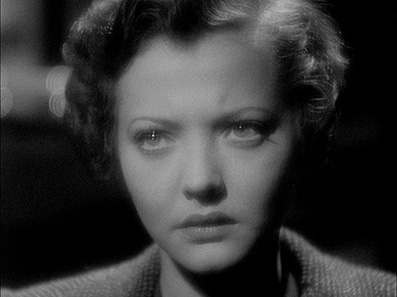
But there's more to consider here. Although Hitch himself later regarded this decision as a mistake, had he not spent ten minutes on the build-up then the film would have been robbed of its showpiece tension sequence. Yet had he instead chosen to spare young Stevie at the last minute, he would have effectively neutered the film's final act, where events and actions are almost exclusively driven by the news of Stevie's death. It's also here that Hitch is at his most cinematically adventurous, notably in Winnie's hallucinatory, post-mortem glimpses of Stevie, seeing his face in the crowd that gathers round her when she faints, or running cheerfully towards her in the street, a case of mistaken identity revealed in what may be the film's most sublimely executed edit.
Winnie's distress, coupled with her horror at her husband's seeming indifference to a tragedy he was instrumental in causing, also gives rise to the film's most emotionally affecting scene, as she wanders shell-shocked into the cinema and becomes momentarily distracted by the Disney cartoon playing on screen and the upbeat audience reaction to it. She sits and even smiles at the on-screen antics, right up until the moment that a serenading bird is shot through the heart by a shadowy figure and plummets to the earth to the mournful strains of 'Who Killed Cock Robin?' The look that crosses Sylvia Sidney's face has haunted me since my very first viewing and remains for me the high point of her consistently strong performance here. This in turn leads to a confrontation that provides the film with an intriguing conclusion, as the leading lady, having inadvertently killed her husband with a carving knife, gets to walk off into (probable) happiness with her new young lover, a ranking policeman who is instrumental in covering up the crime. A few years down the road, such a morally risky ending would have surely have faced the censorial scissors.
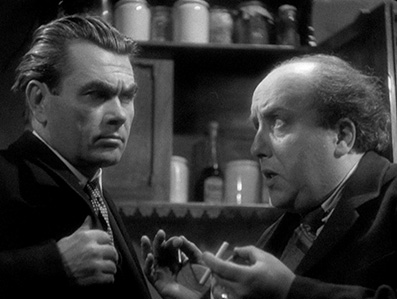
I first saw Sabotage many years ago as part of a season of early Hitchcock films at the National Film Theatre (now the BFI Southbank). I remember distinctly being utterly captivated by it. The scenes I've discussed above stayed with me for years after, and was thus a little bemused by the somewhat dismissive response to the film that I later encountered. Coming back to it after a considerable gap, I do appreciate where this viewpoint is coming from, I just don't happen to share it. Yes, in some respects it's an atypical Hitchcock film, and the absence of a male lead of Robert Donat's charm and screen presence is sometimes keenly felt. But Hitch's command of camera placement, editing and background detail is as keen as ever, and once the film starts firing on all cylinders it never lets up. It remains one of the master's most gloomy and darkly surprising films, and in this humble writer's view, one of his most underrated.
If there's a downside to the extraordinary restoration work being done by the likes of Arrow and Masters of Cinema it's that our expectations of how good a Blu-ray transfer of even older films should look have soared in recent years, and that as a result we sometimes get a little unforgiving when we encounter less than pristine HD transfers. It's perhaps this that prompted a pang of disappointment when I first popped this Blu-ray into my player. The black levels are a touch soft when the light levels drop, and the picture displays the sort of exposure flicker that we once accepted as inevitable on older films before modern digital restoration really made it mark. Dust spots have been minimised, but the odd frame of damage is still visible and the picture jiggles around just a little in the gate. But in other respects this transfer justifies its Blu-ray incarnation, particularly in the level of picture detail, which is far superior to any SD version you may have seen, and in the daylight scenes the contrast is very well balanced, the tonal range generous and the image itself pleasing. Not perfect, perhaps, but still a solid and intermittently impressive job.
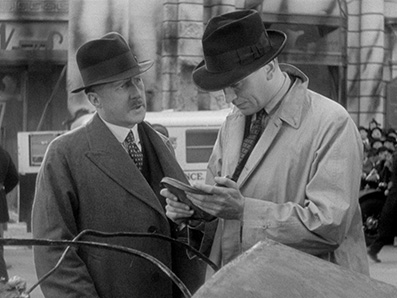
The Linear PCM mono track shows its age in the narrowness of the dynamic range and the treble bias, but there are very few signs of damage, the dialogue is always distinct, and there is next to no background hiss or noise.
Optional English subtitles for the hearing impaired are also included.
Charles Barr Introduction (3:41)
Professor Charles Barr of the School of Art, Media and American Studies at the University of East Anglia provides a brief but interesting overview of Hitchcock's working relationship with left-wing aristocrat Ivor Montague, who was instrumental in introducing him to the work of the silent-era Soviet filmmakers, whose influence is clearly visible on this film.
On Location (11:07)
Robert Powell, who played Richard Hannay in the second remake of Hitchcock's The 39 Steps, takes us on a brief but engaging tour of London locations used in the film. It plays like an episode of a series, but with this running time it's hard to imagine where it was originally screened. The same big spoilers I warned about above are included here, so not one for those who've yet to see the film.
Gallery(2:27)
A rolling gallery of posters and front-of-house and publicity stills, some of them very high quality. Includes a behind-the-scenes shot of the Lord Mayor's show that was faked in a field in Norfolk, and one of Hitch and Oscar Homolka in cheerful mood.
An underrated and too rarely seen film from Hitchcock's late British period that scores on intrigue and tension, and even (or should that be particularly?) from a modern perspective delivers a genuine jolt by breaking a rule that the director otherwise swore by. An Arrow-standard restoration would have been lovely, but despite some visible imperfections, Network's Blu-ray still delivers the goods. Recommended.
|